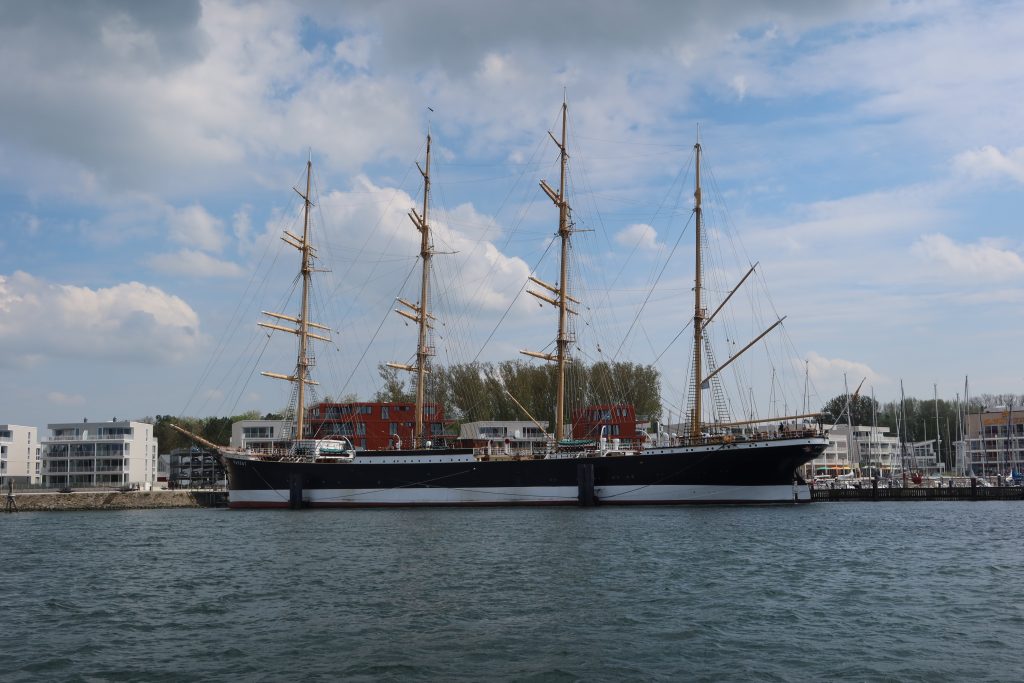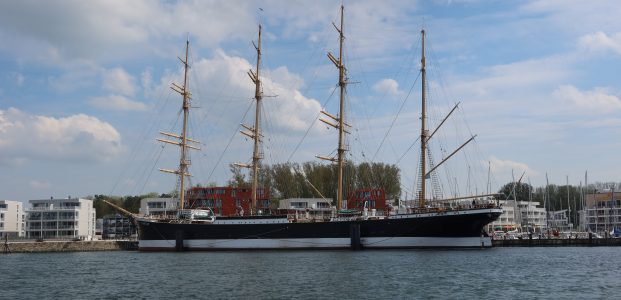In search of the Hanseatic League towns of the North German coast we headed off from Heiligenhafen just after 7am. The wind was bang on the nose, so we motored under the Fehmarn bridge and then set sail trying to head south. As is its wont, the wind had shifted a little and so was …. southerly. But we were sailing at a nice pace, so we tacked down towards Travemünde. After a couple of hours of this, the wind then started to die and with a speed over the ground of around 3 knots, this meant that our VMG towards Travemünde was minimal, so on went the engine. The wind did then build around 1pm, but once again, the wind gods knew where we were heading and they resolutely blew from there. So, we motorsailed. Eventually we had around 25 knots apparent wind and dropped the main in the entrance channel to Travemünde.
As you enter the harbour, you go past the tall ship – the Passat – on the eastern bank of the river. The name Passat is german for trade wind and this is an appropriate name for a ship that traded extensively with countries in the Southern Hemisphere. She is a four-masted steel barque and is known as one of the Flying P-Liners, the famous sailing ships of the German shipping company F. Laeisz. There are very few of these windjammers left, so she is an important historical vessel. She was built in the Blohm and Voss yard in Hamburg and launched in 1911. Her maiden voyage started on Christmas Eve that year and she headed to Cape Horn and the Nitrate ports of Chile.
This was a trade which F.Laeisz dominated and their ships went from Europe to Chile east to west round Cape Horn. This passage could frequently be very difficult because of the prevailing westerly winds. They would round Cape Horn and discharged their outbound cargos in Valparaíso. From there they went to load the nitrate, most frequently in Iquique or Antofagasta, and went back to Europe the “easy” way back around Cape Horn. The nitrate came from the Atacama Desert.
The Passat was interned at Iquique in Northern Chile for the duration of World War I and sailed in 1921 to Marseille and was turned over to France as war reparation. The French government then put her up for sale, and the F.Laeisz Company was able to buy back the ship for £13,000. She was then used again as a nitrate carrier until 1932 when she was sold to the Gustaf Erikson Line of Finland. Along with another windjammer called Pamir (the last commercial sailing ship to round Cape Horn) she took part in the last Great Grain Race in 1949 from Port Victoria around Cape Horn to Europe. Passat rounded Cape Horn in total 39 times.

Travemunde is a beach resort on the north German Baltic Coast and a ferry port for ferries to Scandinavia. We are moored in the Fischereihafen – the old fishing harbour and while there are still a few fishing boats here, they are now outnumbered by yachts.

